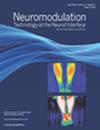Early Sacral Neuromodulation Prevented Detrusor Overactivity in Rats With Spinal Cord Injury
IF 3.5
3区 医学
Q2 CLINICAL NEUROLOGY
引用次数: 0
Abstract
Objectives
Sacral neuromodulation (SNM) has been shown to alleviate bladder dysfunction in patients with overactive bladder and nonobstructive urinary retention. However, the therapeutic effect and mechanism of SNM in neurogenic bladder dysfunction are still not fully understood. Using a rat model of spinal cord injury (SCI), this study aims to investigate the therapeutic effect of early SNM in the bladder-areflexia phase on neurogenic bladder dysfunction and evaluate its possible mechanism.
Materials and Methods
Basic physiological parameters such as body/bladder weight, blood pressure, and electrocardiogram results were measured to evaluate the safety of SNM. Enzyme-linked immunosorbent assays and quantitative real-time polymerase chain reaction were used to examine the expression of proinflammatory factors. Hematoxylin and eosin and Masson’s trichrome staining were used to observe morphological changes, and cystometry was used to evaluate urodynamic changes after SNM treatment. Western blotting and immunofluorescence staining were used to measure the levels of transient receptor potential vanilloid 1 (TRPV1) and calcitonin gene-related peptide (CGRP) in the L6-S1 dorsal root ganglia (DRGs) and bladder. Capsaicin desensitization was used to investigate whether inhibiting TRPV1 could prevent detrusor overactivity in SCI rats.
Results
Early SNM did not affect the body/bladder weight, heart rate, blood pressure, or the expression of proinflammatory cytokines (PGE2, IL-1, IL-2, IL-6, TGF-β, or TNF-α) in the bladders of SCI rats. Morphologically, early SNM prevented urothelial edema (p = 0.0248) but did not influence collagen/smooth muscle in the bladder. Compared with untreated rats with SCI, the rats treated with SNM exhibited increased bladder capacity (p = 0.0132) and voiding efficiency (p = 0.0179), and decreased nonvoiding contraction (NVC) frequency (p = 0.0240). The maximum pressure, basal pressure, postvoid residual, and NVC amplitude did not change significantly. After the SNM treatment, the expression of TRPV1 in the bladder and CGRP in L6-S1 DRGs weredecreased (L6, p = 0.0160; S1, p = 0.0024) in SCI rats. In capsaicin-desensitized SCI rats, urodynamic results showed an increase in bladder capacity (p = 0.0116) and voiding efficiency (p = 0.0048), and diminished NVC frequency (p = 0.0116), while other parameters did not change significantly.
Conclusions
Early SNM prevented urothelial edema morphologically and detrusor overactivity in SCI rats. Inhibition of TRPV1 in the bladder and DRGs may be one of the potential mechanisms for preventing detrusor overactivity by SNM.
早期骶神经调节可预防脊髓损伤大鼠的逼尿肌过度活动
目的:骶神经调控(SNM)已被证明可以缓解膀胱过度活动症和非梗阻性尿潴留患者的膀胱功能障碍。然而,骶神经调控对神经源性膀胱功能障碍的治疗效果和机制仍不完全清楚。本研究以脊髓损伤(SCI)大鼠为模型,旨在探讨膀胱反射期早期SNM对神经源性膀胱功能障碍的治疗效果,并评估其可能的机制:测量基本生理参数,如体重/膀胱重量、血压和心电图结果,以评估SNM的安全性。使用酶联免疫吸附试验和定量实时聚合酶链反应检测促炎因子的表达。血红素和伊红以及马森三色染色用于观察形态学变化,膀胱测量法用于评估 SNM 治疗后的尿动力学变化。采用Western印迹和免疫荧光染色法测量L6-S1背根神经节(DRGs)和膀胱中瞬时受体电位类香草素1(TRPV1)和降钙素基因相关肽(CGRP)的水平。利用辣椒素脱敏法研究抑制TRPV1是否能预防SCI大鼠的逼尿肌过度活动:结果:早期 SNM 不会影响 SCI 大鼠的体重/膀胱重量、心率、血压或膀胱中促炎细胞因子(PGE2、IL-1、IL-2、IL-6、TGF-β 或 TNF-α)的表达。从形态上看,早期 SNM 可防止尿道水肿(P = 0.0248),但不会影响膀胱中的胶原蛋白/平滑肌。与未接受治疗的 SCI 大鼠相比,接受 SNM 治疗的大鼠的膀胱容量(p = 0.0132)和排尿效率(p = 0.0179)增加,非排尿收缩(NVC)频率降低(p = 0.0240)。最大压力、基础压力、排气后残余物和 NVC 振幅没有显著变化。SNM 治疗后,SCI 大鼠膀胱中 TRPV1 和 L6-S1 DRGs 中 CGRP 的表达量减少(L6,p = 0.0160;S1,p = 0.0024)。在辣椒素脱敏的 SCI 大鼠中,尿动力学结果显示膀胱容量(p = 0.0116)和排尿效率(p = 0.0048)增加,NVC 频率降低(p = 0.0116),而其他参数没有显著变化:结论:早期SNM可预防SCI大鼠的尿道水肿形态和逼尿肌过度活动。抑制膀胱和DRGs中的TRPV1可能是SNM预防逼尿肌过度活动的潜在机制之一。
本文章由计算机程序翻译,如有差异,请以英文原文为准。
求助全文
约1分钟内获得全文
求助全文
来源期刊

Neuromodulation
医学-临床神经学
CiteScore
6.40
自引率
3.60%
发文量
978
审稿时长
54 days
期刊介绍:
Neuromodulation: Technology at the Neural Interface is the preeminent journal in the area of neuromodulation, providing our readership with the state of the art clinical, translational, and basic science research in the field. For clinicians, engineers, scientists and members of the biotechnology industry alike, Neuromodulation provides timely and rigorously peer-reviewed articles on the technology, science, and clinical application of devices that interface with the nervous system to treat disease and improve function.
 求助内容:
求助内容: 应助结果提醒方式:
应助结果提醒方式:


